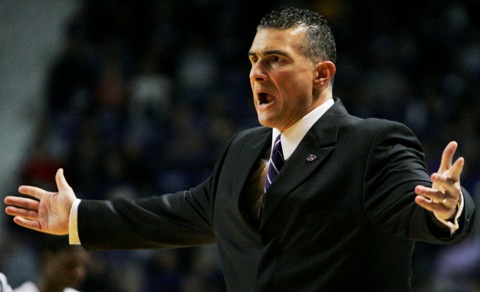Over the last few weeks,
So even before the

At the risk of upsetting Frank Martin, I thought it best to take a deeper look at some of their stats this year.
Through the first eight games of the season,
K-State’s eFG% was a dismal 36.0% versus KU, and that’s the one thing that has been most volatile for them offensively. They have five games with an eFG% below 45% but three games over 60%, all of which came against some of the worst teams on their schedule. Of the four players who have taken the most three-pointers on the team, only one of them (Will Spradling) has made over 33.3 percent.
The Jayhawks also did a terrific job of keeping the Wildcats off the glass, holding them to just a 27.9 OReb% compared to their ninth-rated 40.6% for the year. However, four of their five worst performances on the glass have come against major conference foes, so again, competition appears to be a factor.
The Wildcats also posted a 28.1 FT Rate, which was also a large dropoff from their 48.3 mark for the season. In fact, their previous low was 38.2 in the loss to
So in the end, the reality of how good
But defensive efficiency has been where the team has really excelled, so are those numbers legit? They rank 7th in defensive eFG% , 38th in TO%, and 17th in overall adjusted efficiency according to Pomeroy. They are in the Top 25 in both two- and three-point defense and also are 44th in block percentage. Interestingly, they are outside the Top 225 in both OReb% against and defensive FT Rate.
In terms of shooting,
From a turnover perspective, the Wildcats have forced opponents into a TO% of 26.1 or higher seven times and have posted a TO% of at least 18.3 in every game. It also should not come as a surprise that
One continued area of concern on the defensive end is an ability to limit offensive boards.
I’m less concerned with their ranking for defensive FT Rate, because a couple outliers are playing a factor. UTEP posted a crazy 79.1 percent, and Loyola (IL) was at 61.7 percent, but most of their opponents have been under the national average of 36.6, including
Individually, Martin has eight players averaging at least 18.5 minutes with seven of them scoring at least 6.3 points.
Rodney McGruder leads the team in scoring despite having the fourth highest usage rate on the team, although his shot percentage is second. He’s doing a decent job on the glass on both ends of the floor, rarely turns the ball over, and is shooting just over 55 percent from two-point range. His 29.4 percent shooting on 53 attempts beyond the arc suggests he would be well-served to settle for fewer long jumpers.
Senior forward Jamar Samuels leads the team in rebounding and is second in scoring after reaching double figures in 10 of 11 games. He is drawing fouls at a ridiculous rate, which he has parlayed into a 98.7 FT Rate. Samuels also has solid rebounding percentages on both ends, although he could stand to cut back on his own fouling.
Big man Jordan Henriquez has also shown flashes, including a 17-point outburst against
The enigma right now is freshman forward Thomas Gipson. Over one six-game stretch he averaged 16.0 points and 9.5 rebounds with three double-doubles, but in the six games since he has posted just 4.5 points and 5.2 boards. He gives Martin another able rebounder, and he was drawing 7.3 fouls per 40 minutes heading into the Kansas game. However, his 50.8 percent shooting the free throw line is the worst on the team.
Will Spradling’s sophomore season is off to a good start. His 122.1 ORtg is the best on the team, fueled largely by his 43.6 percent shooting from three-point range. For someone who shoots a lot of threes, his 41.4 FT Rate is relatively surprising.
Martin is also getting contributions from guys like Martavious Irving, Angel Rodriguez, and Shane Southwell, all of whom are among the team leaders in assist rate.
The early portion of their Big 12 schedule doesn’t get any easier after leaving
For now, I’m considering the Wildcats to be the fourth best team in the league, a step below their first three opponents. Their defense will keep them in most games, and the pieces are there to become more consistent on the offensive end. That should be enough to keep them as a fringe Top 25 team for the balance of the year.
Follow me on Twitter (@AndyBottoms) for more of my thoughts on college basketball.























